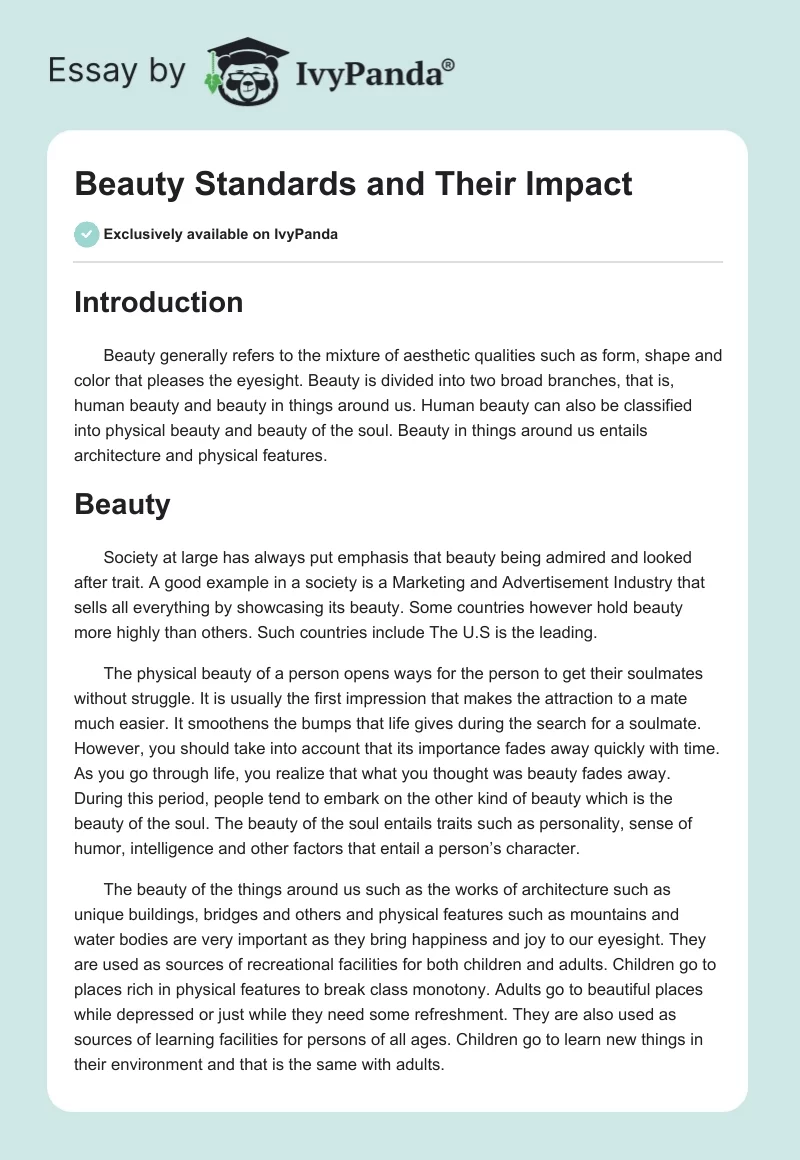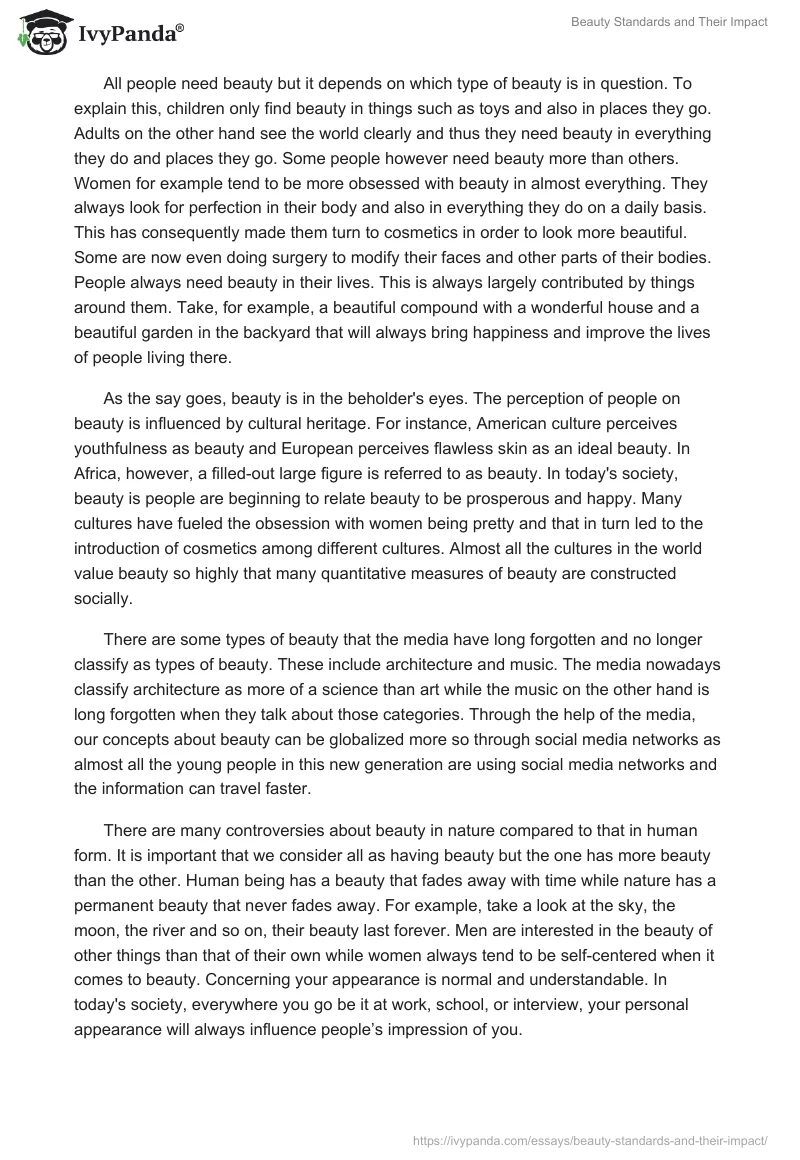Introduction
Beauty generally refers to the mixture of aesthetic qualities such as form, shape and color that pleases the eyesight. Beauty is divided into two broad branches, that is, human beauty and beauty in things around us. Human beauty can also be classified into physical beauty and beauty of the soul. Beauty in things around us entails architecture and physical features.
Beauty
Society at large has always put emphasis that beauty being admired and looked after trait. A good example in a society is a Marketing and Advertisement Industry that sells all everything by showcasing its beauty. Some countries however hold beauty more highly than others. Such countries include The U.S is the leading.
The physical beauty of a person opens ways for the person to get their soulmates without struggle. It is usually the first impression that makes the attraction to a mate much easier. It smoothens the bumps that life gives during the search for a soulmate. However, you should take into account that its importance fades away quickly with time. As you go through life, you realize that what you thought was beauty fades away. During this period, people tend to embark on the other kind of beauty which is the beauty of the soul. The beauty of the soul entails traits such as personality, sense of humor, intelligence and other factors that entail a person’s character.
The beauty of the things around us such as the works of architecture such as unique buildings, bridges and others and physical features such as mountains and water bodies are very important as they bring happiness and joy to our eyesight. They are used as sources of recreational facilities for both children and adults. Children go to places rich in physical features to break class monotony. Adults go to beautiful places while depressed or just while they need some refreshment. They are also used as sources of learning facilities for persons of all ages. Children go to learn new things in their environment and that is the same with adults.
All people need beauty but it depends on which type of beauty is in question. To explain this, children only find beauty in things such as toys and also in places they go. Adults on the other hand see the world clearly and thus they need beauty in everything they do and places they go. Some people however need beauty more than others. Women for example tend to be more obsessed with beauty in almost everything. They always look for perfection in their body and also in everything they do on a daily basis. This has consequently made them turn to cosmetics in order to look more beautiful. Some are now even doing surgery to modify their faces and other parts of their bodies. People always need beauty in their lives. This is always largely contributed by things around them. Take, for example, a beautiful compound with a wonderful house and a beautiful garden in the backyard that will always bring happiness and improve the lives of people living there.
As the say goes, beauty is in the beholder’s eyes. The perception of people on beauty is influenced by cultural heritage. For instance, American culture perceives youthfulness as beauty and European perceives flawless skin as an ideal beauty. In Africa, however, a filled-out large figure is referred to as beauty. In today’s society, beauty is people are beginning to relate beauty to be prosperous and happy. Many cultures have fueled the obsession with women being pretty and that in turn led to the introduction of cosmetics among different cultures. Almost all the cultures in the world value beauty so highly that many quantitative measures of beauty are constructed socially.
There are some types of beauty that the media have long forgotten and no longer classify as types of beauty. These include architecture and music. The media nowadays classify architecture as more of a science than art while the music on the other hand is long forgotten when they talk about those categories. Through the help of the media, our concepts about beauty can be globalized more so through social media networks as almost all the young people in this new generation are using social media networks and the information can travel faster.
There are many controversies about beauty in nature compared to that in human form. It is important that we consider all as having beauty but the one has more beauty than the other. Human being has a beauty that fades away with time while nature has a permanent beauty that never fades away. For example, take a look at the sky, the moon, the river and so on, their beauty last forever. Men are interested in the beauty of other things than that of their own while women always tend to be self-centered when it comes to beauty. Concerning your appearance is normal and understandable. In today’s society, everywhere you go be it at work, school, or interview, your personal appearance will always influence people’s impression of you.
Looking at the other side of the coin, the standards that society has put on women have enabled some women to thrive and become successful. Let’s take America for example, a country that produces many models and enables women to develop their careers in terms of beauty. It has led to many other opportunities such as selling cosmetics and fashion design.
Conclusion
The physical beauty of human beings fades away with time. The beauty of nature and of the soul is permanent. Society has set some unrealistic standards for women in terms of beauty which are vague and should be overlooked.
References
Skivko, M. (2020). Deconstruction in Fashion as a Path Toward New Beauty Standards: The Maison Margiela Case. ZoneModa Journal, 10(1), 39-49.
McCray, S. (2018). Redefining Society’s Beauty Standards.
Capaldi, C. A., Passmore, H. A., Ishii, R., Chistopolskaya, K. A., Vowinckel, J., Nikolaev, E. L., & Semikin, G. I. (2017). Engaging with natural beauty may be related to well-being because it connects people to nature: Evidence from three cultures. Ecopsychology, 9(4), 199-211.


